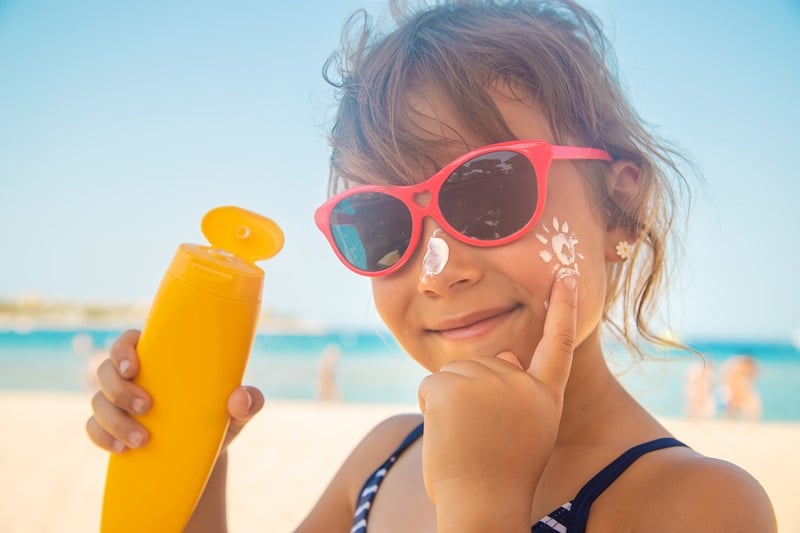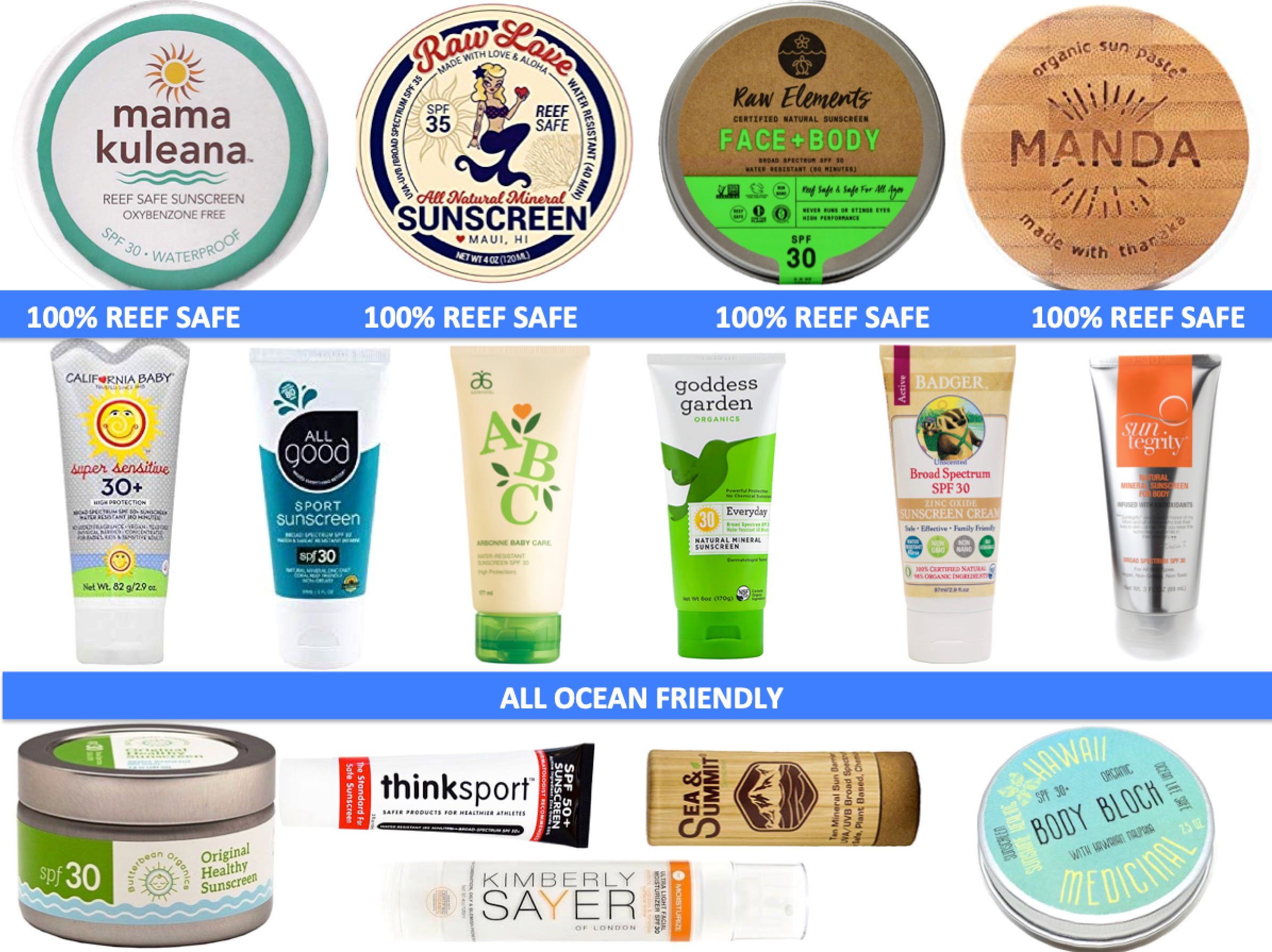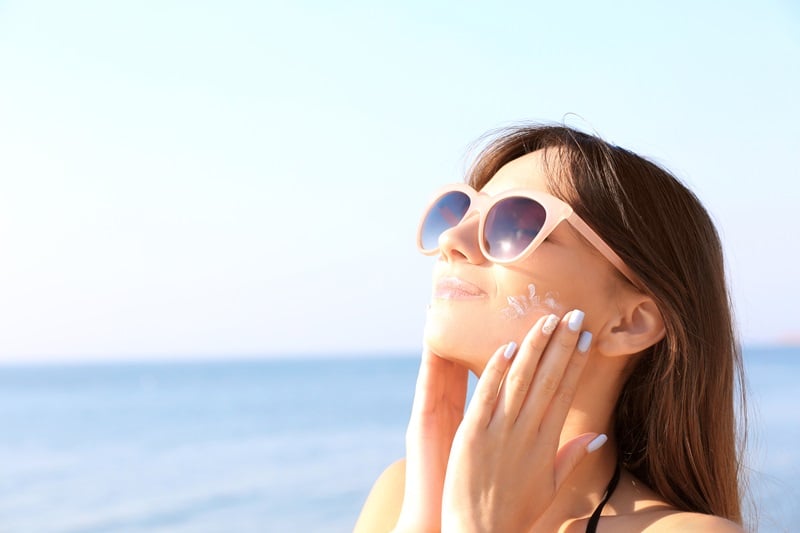Reef-safe sunscreen is designed to provide sun protection while minimizing the environmental impact on coral reefs and marine life. As awareness about the ecological impact of conventional sunscreens grows, the demand for reef-safe options has surged. If you’re passionate about the ocean, coral reefs, and marine wildlife, let that passion extend to the sunscreen you choose. In our Eco-Friendly Snorkeling blog, we touched on this, but here’s the 101 on reef-safe sunscreen in more depth.
Maui County Law: Ban of Non-Mineral Sunscreen
On October 1, 2022, Maui County made a big environmental move by prohibiting the sale, distribution, and use of any sunscreens that aren’t mineral-based. This means if you’re buying or using sunscreen in Maui County, it has to be made with minerals, specifically zinc oxide or titanium dioxide. These two minerals are not only natural but also have the FDA’s seal of approval, being marked as GRASE (Generally Recognized as Safe & Effective).
This rule on Maui adds to an earlier law across the State of Hawaiʻi. This statewide regulation, which began in January 2021, already banned the sale of sunscreens containing oxybenzone and octinoxate. These chemicals are known to affect Hawaii’s marine life and ecosystems badly. Maui took it a step further to protect its oceans by allowing only mineral sunscreens.
What Makes Sunscreen Not Reef-Safe?
Despite the reef-safe label on many sunscreens, some of these products still include ingredients damaging to corals, fish, and marine life. The term “reef-safe sunscreen” lacks official regulation, which means there’s no standardized definition ensuring the safety of these products for marine ecosystems. It falls on you as a consumer to scrutinize the label and educate yourself on which ingredients are truly safe for the marine environment.
Traditional sunscreens, as opposed to reef safe sunscreen options, often contain chemical UV filters like oxybenzone and octinoxate, which have been linked to coral bleaching and other harmful effects on marine ecosystems. When swimmers, snorkelers, and surfers wearing these sunscreens enter the ocean, these chemicals can wash off and accumulate in the water, posing a threat to coral and marine life.
In light of this, the push for truly reef safe sunscreen becomes all the more critical. By opting for reef-safe sunscreen, you’re choosing products that deliberately avoid these damaging chemicals, thus reducing your environmental footprint in marine settings. This conscientious choice supports the health of coral reefs and marine life, ensuring the sustainability and enjoyment of oceanic environments for future generations.
Key Ingredients to Avoid
To protect coral reefs, it’s recommended to avoid sunscreens with the following ingredients:
• Oxybenzone (Benzophenone-3)
• Octinoxate (Ethylhexyl methoxycinnamate)
• Octocrylene
• Homosalate
• 4-methylbenzylidene camphor
• Parabens
• Microplastics or nano-sized particles (which can be ingested by marine life)
Preferred Ingredients in Reef-Safe Sunscreens
Reef-safe sunscreens typically use mineral (physical) UV filters, which sit on top of the skin to reflect UV rays away. The two main ingredients considered safe for reefs are:
• Zinc Oxide
• Titanium Dioxide
These are often non-nano in size to minimize the risk of marine ingestion and bioaccumulation.
Reef-Safe Sunscreens
Toxic Sunscreens
Photos courtesy of Save The Reef
Certification and Labels
There’s no official certification for reef-safe sunscreens, leading to some confusion and greenwashing. Greenwashing is when a product is marketed as environmentally friendly when, in reality, it might not be. Consumers are advised to read ingredient lists carefully. Looking for products marketed as “reef-safe,” “ocean-safe,” or “coral-friendly,” is a step in the right direction, but always verify the ingredients. These terms sound reassuring and suggest that the product doesn’t harm marine ecosystems, but without a standardized certification, these labels can be misleading.
Additional Considerations for Reef Safe Sunscreens
Biodegradability: Choosing biodegradable sunscreens is an essential step toward minimizing your environmental footprint while enjoying ocean activities. Biodegradable means that the sunscreen can naturally decompose without leaving harmful residues that could affect marine life. Traditional sunscreens can linger in the environment, posing risks to fish, coral, and other sea creatures. By selecting biodegradable options, you’re ensuring that even if your sunscreen washes off in the water, it will break down into harmless substances that won’t disrupt the delicate ocean ecosystems.
Broad Spectrum: When it comes to protecting your skin from the sun, broad-spectrum sunscreens are the way to go. These products offer defense against both UVA and UVB rays. UVA rays are primarily responsible for aging the skin, causing long-term damage like wrinkles and age spots. UVB rays, on the other hand, are the main cause of sunburn. Both types of UV radiation can lead to skin cancer. By choosing a broad-spectrum sunscreen, you’re not only preventing sunburn but also guarding against deeper skin damage and potential health risks.
Water Resistance: For those who love spending time in the water, whether swimming, snorkeling, or diving, water-resistant sunscreen is a game-changer. Unlike regular sunscreens, water-resistant formulas are designed to stay on your skin longer, even when you’re swimming or sweating. This means they’re less likely to wash off as quickly, which not only ensures better skin protection but also reduces the amount of sunscreen that ends up in the ocean. However, it’s important to remember that “water-resistant” does not mean “waterproof.” You’ll still need to reapply sunscreen regularly, especially after drying off with a towel or after extended periods in the water, to maintain effective protection.
Maui Snorkeling Boat Tours
Join us on a morning or afternoon tour to see Molokini Crater, Turtle Town, or Coral Gardens!
Reef-Safe Sunscreens
Here is a list of sunscreens considered to be reef-safe, according to Hawaii.com. Sunscreens made in Hawaii are marked with an * asterisk.
• *Kokua Sun Care Hawaiian SPF 50 Natural Zinc Sunscreen
• *Mama Kuleana Waterproof SPF 30 Reef-safe Sunscreen
• *Little Hands Hawaii SPF 35+ All-natural and Organic Sunscreen
• Manda Organic SPF 50 Sun Paste
• *Raw Love SPF 35 All-natural Mineral Sunscreen
• Thinksport SPF 50 Sunscreen
• All Good SPF 30 Sport Sunscreen Lotion
• Babo Botanicals SPF 30 Clear Zinc Lotion
• Suntegrity Natural Mineral Sunscreen
• Badger SPF 30 Unscented Sunscreen Cream
• Raw Elements SPF 30 Certified Natural Sunscreen
• Stream2Sea SPF 30 Mineral Sunblock
• Loving Naturals Clear Body SPF 30+ All-natural Sunscreen
• Banana Boat Simply Protect SPF 50+ Sunscreen (spray, not lotion)
• Olita Mineral Sunscreen Lotion SPF 30
Maui Snorkeling Molokini Snorkeling and Slide Tours:
Now that you’ve learned all about reef-safe sunscreen, slather some on and join us for one of our Molokini snorkeling tours!
Maui Morning Tour
Start your day with the Maui Snorkeling Morning Tour, a journey that spans from 7 AM to 12 PM, available every day of the week. This adventure features two premier snorkeling spots.
Our initial destination is the renowned Molokini Crater, followed by a visit to the enchanting Turtle Town Maui or Coral Gardens. As we navigate towards these spectacular Maui snorkeling sites, keep an eye out for the majestic Humpback Whales passing through the Hawaiian waters.
Maui Afternoon Tour
The Maui Afternoon Tour, an adventure that spans from 1 PM to 4 PM offers a perfect opportunity for anyone looking for a more serene Molokini snorkeling adventure. With favorable weather, you’ll enjoy snorkeling and sliding at the Molokini Crater away from the typical crowds. Should conditions turn less favorable for safe and comfortable snorkeling, Coral Gardens or Turtle Town Maui will provide a similarly relaxed snorkel and slide experience without the crowds.
Enjoy delicious meals, snack to your heart’s content, and sip on coffee, tea, juices, and soft drinks while you’re aboard. We equip you with the finest snorkeling gear—high-quality snorkels, fins, optical masks, and flotation belts. And for extra fun, we throw in boogie boards, a thrilling 25-foot water slide, and swimming noodles.
Maui Snorkeling, renowned for the best snorkeling Maui has to offer, welcomes sea adventurers of all ages and skill levels. We offer special rates for Kama’aina and youth, with kids under 4 joining for FREE, making it the ultimate family-friendly experience and one of the best things to do in Maui with kids!
Listening to our guests’ overwhelming requests, we’ve introduced a BYOB policy, allowing you to bring and enjoy your favorite alcoholic beverage after all the in-water activities. So why wait? Dive into the adventure of a lifetime with one of our tour packages and snorkel Maui today!
Maui Snorkeling Boat Tours
Join us on a morning or afternoon tour to see Molokini Crater, Turtle Town, or Coral Gardens!
The Bigger Picture
Maui’s reefs are not only a source of natural beauty but also vital to the island’s marine biodiversity and its economy, particularly in sectors like tourism and fishing. Protecting coral reefs goes beyond choosing the right sunscreen. It involves broader environmental efforts, including reducing pollution, combating climate change, and supporting marine protected areas. While switching to reef-safe sunscreen is a positive step, it’s part of a larger suite of actions needed to preserve marine ecosystems for future generations.
In conclusion, reef-safe sunscreen is a critical component of environmentally responsible sun protection. By choosing products that are free from harmful chemicals and opting for mineral-based, biodegradable options, individuals can enjoy the sun while minimizing their impact on the oceans and coral reefs.




